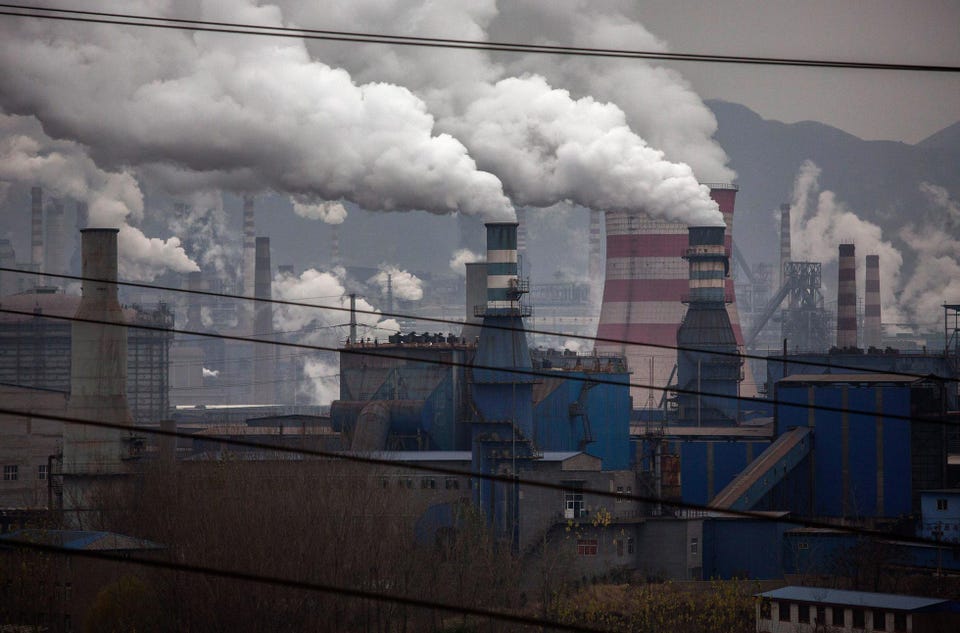Energy Why The U. S. Can’t Curb The World’s Carbon Dioxide Emissions Robert Rapier Senior Contributor Opinions expressed by Forbes Contributors are their own.
New! Follow this author to improve your content experience. Got it! Jul 17, 2022, 07:09pm EDT | Share to Facebook Share to Twitter Share to Linkedin HEBEI, CHINA – NOVEMBER 19: Smoke billows from smokestacks and a coal fired generator at a steel . .
. [+] factory on November 19, 2015 in the industrial province of Hebei, China. China’s government has set 2030 as a deadline for the country to reach its peak for emissions of carbon dioxide, what scientists and environmentalists cite as the primary cause of climate change.
At an upcoming conference in Paris, the governments of 196 countries will meet to set targets on reducing carbon emissions in an attempt to forge a new global agreement on climate change. (Photo by Kevin Frayer/Getty Images) Getty Images Earlier this month the BP Statistical Review of World Energy 2022 was released, covering energy data through 2021. Previously, I provided a summary of the data .
Today, I want to focus on the trends in global carbon dioxide emissions. A year ago, as a result of the Covid-19 pandemic, BP reported a 6% decline in global carbon dioxide from 2019 to 2021. This was the largest such decline since World War II.
It was widely expected that emissions would bounce back in 2021, and they did. As the world recovered from the first Covid-19 wave, global carbon dioxide emissions increased by 5. 6% from 2020 to 2021.
That was the fastest growth rate in nearly 50 years. Emissions were only 0. 8% short of the all-time high set in 2018.
They are on a trajectory to reach a new all-time high this year unless a recession curbs global energy demand in the second half of the year. Global carbon dioxide emissions 1965-2021 Robert Rapier There is a huge disparity between carbon dioxide emissions of developed countries and those of developing countries. The 38 member countries of the Organisation for Economic Co-operation and Development (OECD) are high-income countries generally regarded as developed countries.
Carbon dioxide emissions in these countries have been in decline for 15 years, and are at approximately the same level they were at 35 years ago. MORE FOR YOU Here’s The List Of 317 Wind Energy Rejections The Sierra Club Doesn’t Want You To See Revisiting The Blame For High Gas Prices Why Do ‘Fracking’ Opponents Ignore Its Moral Benefits? Carbon dioxide emissions 1965 to 2021 Robert Rapier Non-OECD countries, on the other hand, have seen an explosion in the growth of carbon dioxide emissions. There are two primary reasons for this disparity.
First, coal played an important role in the early development of OECD, but it is now being phased out. The non-OECD countries are going through a similar development phase by using coal, and that is driving up their carbon dioxide emissions. The second major reason is that the majority of the world’s population lives in developing countries.
Their standards of living are increasing, and that generally entails an increase in energy consumption. Even though per capita emissions in these countries is low, a large population of people that is slightly increasing per capita emissions is having a large overall impact on global emissions. But this poses a major challenge in controlling the world’s carbon dioxide emissions.
Around 60% of the world’s population lives in the Asia Pacific region. Per capita consumption is much lower than in the world’s developed countries, but billions of people slowly increasing consumption has been the driving factor behind rising carbon dioxide emissions for decades. Since 1965, carbon dioxide emissions in the U.
S. and the EU haven’t changed much. But they have grown steadily in Asia Pacific region, reaching a new record high in 2021.
Asia Pacific’s emissions are now over double the combined emissions of the U. S. and the EU.
Regional CO2 emissions 1965 to 2021 Robert Rapier It’s not just China and India either. Multiple Asia Pacific countries are both among the largest carbon dioxide emitters and are among the leaders in the growth of emissions. Top 10 global emitters of carbon dioxide in 2021.
Robert Rapier I often encounter people who can’t seem to grasp why we aren’t addressing rising carbon dioxide emissions. These graphics illustrate the challenge. Although the U.
S. has put more carbon dioxide into the atmosphere over time than any other country, China is destined to surpass us. That’s why the U.
S. can’t make much of a dent in this problem unilaterally, unless we invent new technologies that can efficiently pull carbon dioxide from the air and sequester it. Global carbon dioxide emissions have been driven by the Asia Pacific region for the past 50 years, and there’s no sign that this is slowing down.
The world doesn’t stand a chance of curbing carbon dioxide emissions without figuring out a way to stop emissions growth in these populous developing countries. Follow me on Twitter or LinkedIn . Check out my website or some of my other work here .
Robert Rapier Editorial Standards Print Reprints & Permissions.
From: forbes
URL: https://www.forbes.com/sites/rrapier/2022/07/17/why-the-us-cant-curb-the-worlds-carbon-emissions/



